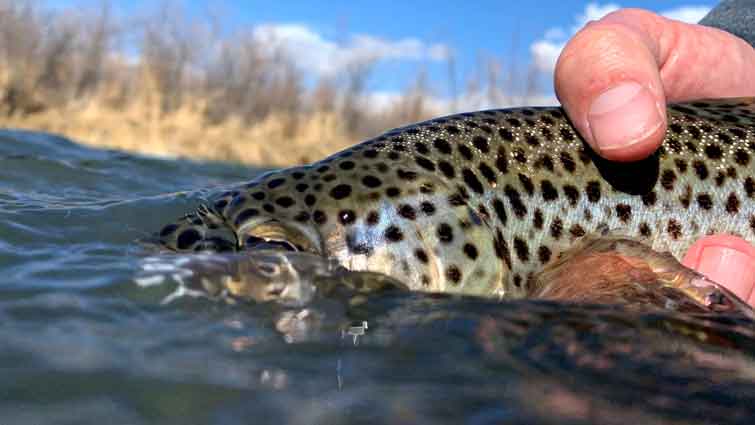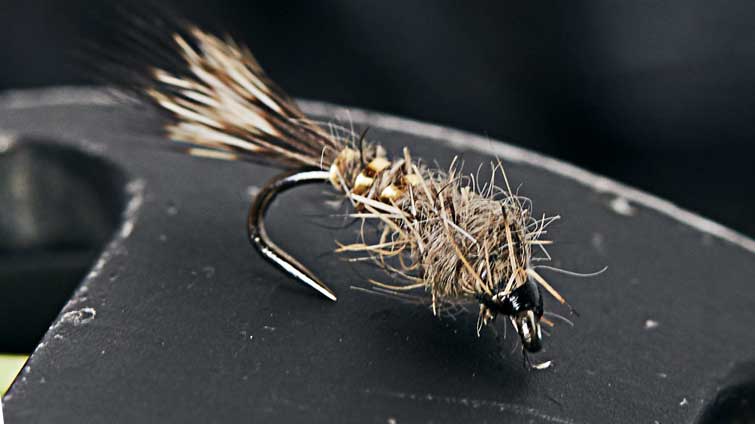A nymph fly, in simple terms, is a trout fly that resembles the naturally occurring insect larvae and nymphal stages of aquatic invertebrates common to streams, rivers, ponds, and lakes.
Nymphs or subterranean insects imitate subsurface insects and aquatic worms in bodies of water. Nymphs are an important subsurface food source for trout. This is why nymphing abilities are required in every fly fisherman's arsenal.
Nymphs can be identified by having no wings, sharp piercing mouth parts, and either resemble aquatic worms or larvae. In this article, we'll discuss the basic entomology of flies and how to match the hatch when you're on the water.

Basic Entomology of Flies
Most aquatic insects have a lifecycle that can be divided into four parts. In the Nymph cycle, the insect lives in the water, typically bottom-feeding or living near vegetation. In this stage, they eat other larvae and small invertebrates until large enough to pupate. The four life cycles of most aquatic insects are:

The nymph is an immature stage that usually lives underwater. The emerger stage is the time of development after molting when the insect is unable to live on dry land. The adult stage of insects is morphologically fully developed, with wings and functional reproductive organs.
Insects begin their lives as eggs, hatching into nymphs which later become adults. Flies are often classified by the type of pupa they pass through before becoming adults or spinner flies if they do not go through any metamorphosis at all.
Nymph Stage
The Nymph stage is when insects first come out of their eggs and are still growing. Nymphs look a lot like adult insects but do not have wings or functional reproductive organs. Nymphs live underwater and breathe through branchial chambers under their thorax until they are ready to emerge as adults.

Insects in their Nymph cycle have no functional wings and live below the surface of the water. They also have an exoskeleton that can be shed during molting stages to grow larger. This is why it's so important for fishermen to match the hatch when flying fishing because different stages of development require unique patterns to imitate them attractively.

Emerger Stage
The Emerger stage is when the insect starts to come out of the water. They are getting ready to fly but cannot yet. They are still developing their wings and reproductive organs. In order to breathe, they will take small breaths from the surface of the water until they can fly away.

Emerger patterns are used to imitate the emerging or flying insects that trout and other fish feed on. After emerging from the nymph stage, insects go through the Emerger stage, where they develop their wings and reproductive structures fully before becoming adults.

Adult or Dry Fly Stage
The Adult stage is when insects have fully developed wings and reproductive organs and can fly. The adult or dry fly cycle for aquatic insects is typically the most important stage of their lifecycle. Midge flies are no exception; they can be readily identified flying around, near, or on top of the water, and are commonly fished during the day. They are found in all types of aquatic habitats worldwide.

Insects go through several molting stages before becoming adults. The adult stage is when insects have fully developed exoskeletons and functional wings that allow them to fly off to mate and reproduce young. Flies spend most of their life cycle in either aquatic or terrestrial environments but always return to the water for breeding at some point.

Spinner Stage
The Spinner stage is when nymphs leave their aquatic environment for a terrestrial one. The wings are not developed enough to fly, so they use little back legs to catch the air and glide to land, where they complete their development.
Spinners are insects that have mated or passed and are floating in the water, but their wings are not developed enough for them to fly. They get their name because they spin around in the water. Spinners can either lay eggs or hibernate, depending on how well suited they are for survival in the wild.
Limited Life Cycles
Some insects have limited life cycles, like Stoneflies. Stoneflies start as nymphs and move directly to their adult cycle. Nymphs can be imitated using adults, but both stages should only last a few days.

The stonefly has a tough three-stage life cycle, with the egg, nymph, and adult stages all occurring only in moving water. A stonefly nymph may survive for anywhere from 1 to 3 years on the bottom of a river or lake.
Stoneflies typically live about 24 hours as adults because they do not feed during their flying life cycle. Their role in nature is to reproduce, so they mate quickly after taking flight. Stoneflies are attracted to light, which attracts other insects to devour them upon landing. Because of this, fishermen often fish with glow beads or lights for visual attractors.

Matching the Hatch When Fly Fishing
It's important for fishermen to have all sorts of flies available depending on what phase of development an insect is currently in so you can match your pattern to the hatch. If you can't see what stage of development they're in, then there's a good chance you won't be able to catch any fish because trout and other fish need to eat to survive.
Since nymphs are underwater while only having one pair of functional wings, wet flies should mimic this life cycle by being fished under the water. Emerger patterns imitate insects when they've emerged from their aquatic environment but still have underdeveloped wings that don't let them fly away yet.
These should be fished under an indicator or near the surface using a dead drift float with a swing at the end. Adult flies live most of their lives on land and water only during the breeding season.
To identify different fly species, look for the characteristics that set them apart, like:
- Midges - Midges are tiny flies that can be mistaken for mosquitoes but aren't biting you. They're big swarms of them flying around and above your head all the time.
- Mayflies - If the fly has horizontal wings that resemble a sailboat, it's most likely a mayfly. They generally appear/hatch in the morning and evening hours (though sometimes more), and trout eating something on the surface slowly and methodically is a good sign. It's quite probable it's a mayfly.
- Caddisflies - The wings of caddisflies are folded rooflike over the abdomen at rest, resembling moth wings. Many-jointed antennae are long and have a large basal segment.
- Stoneflies - Two claws at the end of each leg, wing pads in mature larvae, and an abdomen ending in two long, segmented filaments are some of the characteristics that distinguish stonefly larvae. Wing pad shape, gill presence and position, and labium form are examples of characters that may be used to identify adult stoneflies.
Knowing these characteristics and referring to the seasonal hatch chart every time you go fishing will help you figure out what's hatching, so it's easier to imitate the insect that trout are eating.

How Do You Tell If a Fly Is a Nymph?
The top of most nymphs has a bead head to ensure they reach the bottom of the stream. Before a hatch, emerging flies are ideal. If you notice the tail of the fish sticking out of the water, it's likely that it's feeding on emerging insects. Emerging flies are at their most vulnerable just before hatching.
Nymphs are insects that live in the water as larvae and then change into adults that live on land. You can identify a nymph if it has gills on its abdomen or false legs located at the end of its abdomen. A nymph will have no wings. They are tiny and have no mouthparts.
Knowing what you're looking for when fishing will save you a lot of time and hassle because it's easier to find patterns that imitate insects on the stream than tailor your own pattern each time. Nymphs live underwater while maturing into adults of their respective species. Nymph flies are meant to mimic the immature stage of aquatic insects like:
- Caddisflies
- Stoneflies
- Mayflies
- Midges, and
- Dragonfly larvae

What Does a Rainbow Warrior Fly Imitate?
The Rainbow Warrior imitates a midge or mayfly nymph that is coming out, but most of the time, it's just a flashy insect that catches the trout's attention. The pattern's shiny head, pearl body, and red thread make it hard for trout to resist as a dropper or fished solo.

What Is the Difference Between a Midge and a Nymph?
In its Nymph stage, the Midge typically has wormlike movements, which occur by contracting its body. This is what gives it the characteristic look of a worm moving through the water. This movement helps it hide from prey and helps move up to take better advantage of currents for faster movement.
In fly fishing, the term "midge" has a particular bug as its definition. The word "nymph" refers to aquatic insects of many species, such as midges, that pass through several life phases. For example, you could be using a "midge nymph" fly.
The Midge Nymph has no noticeable front legs and will typically be the smallest insect you'll come across.

Does a Nymph Fly Sink?
Nymph flies do sink. A bead head nymph is a weighted fly with a bead at the top that differs from a non-weighted traditional nymph in that no additional weight is put on the fly's head. Beadhead nymphs are heavier and sink faster than non-beadhead flies due to their added weight.
Nymphs exist on the sub-surface of the water. Nymph flies have round bodies that weigh them down so they can reach the bottom quickly without being pushed too far away by the currents of the stream. A bead head on a nymph makes it sink even faster due to the extra weight of the bead itself and how it's placed on top of the hook shank (the bend in the hook).
Whether it's trout, salmon, or bass that you're fly fishing for, the best way to catch them is with a nymph. Nymphing abilities are essential in every fisherman's arsenal because of the fact that there are always bugs beneath the surface. The flies imitate these underwater insects and can be fished either dry on top of the water or wet under it, depending on what type of fish you're targeting.
A nymph fly is an effective tool for catching fish because of its natural, realistic appearance. If you enjoy fishing or fly-fishing and want to increase your chance of success with the technique, try using a nymph pattern next time you go out on the water. This style of fly offers something that all fishermen like - it's simple!






